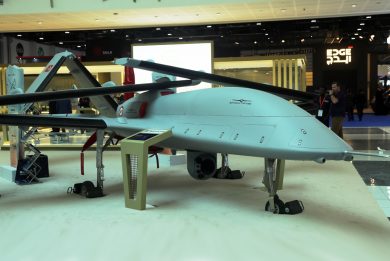
SAHA Expo 2024 – Baykar Kemankeş mini-cruise missiles close to finishing the development phase
While the Baykar internal stand was dominated by the 14.5 metres long Kizilelma combat UAV, two much smaller systems were visible, the Kemankeş 1 and Kemankeş 2 mini-cruise missiles which are now in advanced development phase
To cope with critical targets located deep in enemy territory Baykar developed two mini-cruise missiles, one air-launched and one ground-launched, known respectively as Kemankeş 1 and Kemankeş 2. Both are fitted with an artificial intelligence-supported autopilot system, which allows a high degree of autonomy.

The Kemankeş 1 dimensions and mass were dictated by the fact that it was being designed to be used from UAVs. Its mass at launch is 40 kg, 5 kg being dedicated to the payload. It is 1.73 metres long and features two folding low wings; these are retracted during the approach and are extended at launch, sweeping forward, reaching a wingspan of 1.14 metres, An X empennage at the rear ensures the missile control. The Kemankeş 1 is powered by a jet engine located at the rear, two air intakes being visible on the sides of the missile. The engine is the IL170 designed by idealab of Turkey; it weighs less than 1.85 kg, has a diameter of 112 mm and a length of 282 mm, and provides a 170 N thrust with a specific fuel consumption of 47 g/kN.s. The fuel tank allows for a 30 minutes endurance, which gives a 150 km operational range considering the 160 knots IAS cruise speed, maximum speed being 200 knots, the data link having a 100 km range. Telemetry data and video can be relayed to the ground control station exploiting the launch platform as radio relay.
Baykar obviously promotes its Kemankeş 1 as a weapon system to be installed under the pylons of its Bayraktar Akinci, Bayraktar TB2, and Bayraktar TB3. With a service ceiling of 15,000 feet and an operational ceiling of 12,000 feet, the mini-cruise missile navigates thanks to a GNSS system, the missile being equipped with strong electronic counter measures. Satellite navigation can be exploited also in the terminal attack phase, however here the electro-optic payload installed at the front becomes the main navigation item until the point of impact. The AI-assisted optical guidance set is stabilised on two axes and is fitted with a 36x optical zoom, narrow field of view being 1.10° while wide field of view is 59.13°. The suite includes a laser rangefinder with a range up to 2.8 km. The Ai-based optronic guidance system allows identifying and engaging targets with pinpoint accuracy, even under challenging conditions according to Baykar. Once over the target the Kemankeş 1 can adopt a top-attack profile, diving on its objective at a speed of 400 knots, adding kinetic energy effects to those of the warhead, the latter too by a national company.

Physical limitations imposed on the airborne Kemankeş 1 provided did not applied to the Kemankeş 2, the latter being ground launched. To reach the minimum lift speed two systems are proposed. The missile can be installed over a utility vehicle that speeds against the wind until the speed is reached, then releases the missile from a short ramp, while a rocked-assisted take off is also envisaged adding a booster to the missile. At launch the mass of the Kemankeş 2 is 70 kg, 20 of which representing the payload. It is fitted with a high wing with winglets which has a 1.35 metres span, the missile being 2.47 metres long.
Numerous subsystems are in common with the air-launched version, however performances are different, for example operational range is increased at over 180 km due to a bigger fuel tank which brings endurance up to 40 minutes, while cruise and maximum speeds are lower, respectively 120 ad 180 knots, aerodynamics and weight considerations influencing these parameters. Navigation and terminal attack guidance remain also similar as well as the dive speed.
Flight tests of both systems started last year and are now in an advanced phase, the company not providing a possible date for the end of the development testing.
Photos by P. Valpolini



